Canon EF 400mm f/4 DO IS II USM User Guide
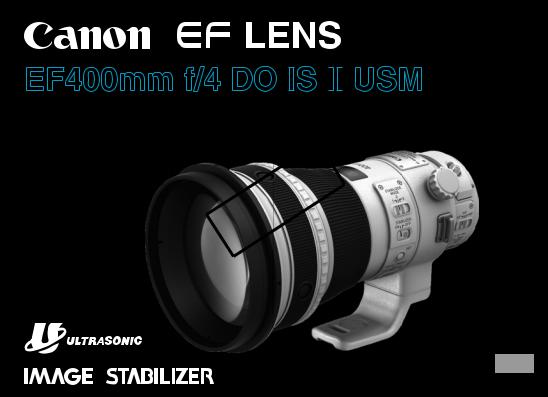
EF400mm f/4 DO IS II
 USM
USM
COPY
ENG
Instructions
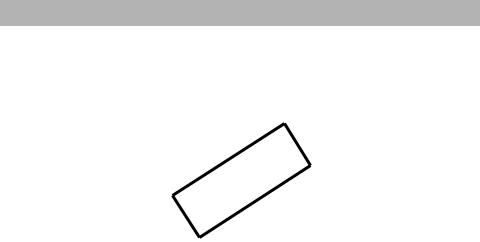
Thank you for purchasing a Canon product.
Canon’s EF400mm f/4 DO IS II USM is a high- |
removed more easily than before. |
||
performance super telephoto lens, for use with EOS |
5. Ultrasonic motor (USM) for fast, quiet autofocus. |
||
cameras, which includes a newly-developed DO lens |
6. Manual focusing is available after the subject |
||
(Gapless Dual-Layer Diffractive Optical Element) and |
comes into focus in autofocus mode (ONE SHOT |
||
is designed to be compact and lightweight. |
AF). |
||
OO“DO” stands for Diffractive Optics. |
|
7. An AF stop button to pause autofocus whenever |
|
|
desired. |
||
OO“IS” stands for Image Stabilizer. |
|
||
|
8. A power focus mode enables smooth focus |
||
OO“USM” stands for Ultrasonic Motor. |
|
||
|
change. |
||
Features |
|
||
|
9. A focus preset function for advance storage |
||
1. An optimal combination of DO elements |
of focusing positions in memory to allow |
||
instantaneous focusing. |
|||
providing good compensation of chromatic |
|||
10. Can be used with EF1.4× III/EF2× III extenders. |
|||
aberration and an aspherical element |
|||
11. Attachment slot provided for wire-type security |
|||
providing good compensation of aberrations, |
|||
lock, located under the cover for the orientation |
|||
giving superior definition as well as achieving |
|||
locking knob. |
|||
compactness. |
|
||
COPY |
|||
2. The Image Stabilizer gives the equivalent effect |
12. Tight seal structure provides excellent dustproof |
||
and drip-proof performance. However, it is unable |
|||
of a shutter speed 4 stops* faster (when using |
|||
to provide complete protection from dust and |
|||
an EOS-1D X). |
|
||
|
moisture. |
||
Also, a third Image Stabilizer mode effective for |
|||
13. Designed for lighter weight with parts made of |
|||
shooting irregularly moving subjects. |
|
||
|
magnesium alloy. |
||
3. SWC (Subwavelength Structure Coating) |
|||
|
|||
reduces flare and ghosting. |
|
|
|
4. Using a fluorine coating on the foremost and |
* Based on CIPA (Camera & Imaging Products |
||
rearmost lens surfaces allows adhered dirt to be |
Association) standards. |
||
ENG-1
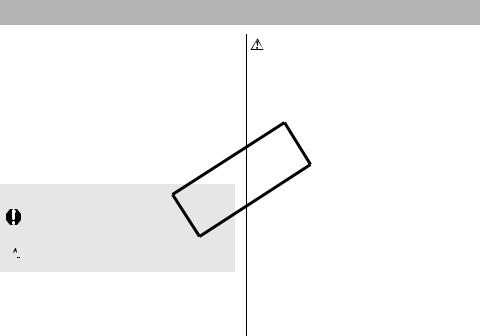
 Safety Precautions
Safety Precautions
Handling Cautions |
|
|
Safety Precautions |
||||
OO If the lens is taken from a cold environment into a |
|
OO Do not look at the sun or a bright light source |
|||||
|
|
warm one, condensation may develop on the lens |
|
through the lens or camera. Doing so could result in |
|||
|
|
surface and internal parts. To prevent condensation |
|
loss of vision. Looking at the sun directly through the |
|||
|
|
in this case, first put the lens into an airtight plastic bag |
|
lens is especially hazardous. |
|||
|
|
before taking it from a cold to warm environment. Then |
|
OO Do not point the lens or camera at the sun or |
|||
|
|
take out the lens after it has warmed gradually. Do the |
|
photograph it. This is because the lens concentrates |
|||
|
|
same when taking the lens from a warm environment |
|
the sun’s rays even when the sun is outside the image |
|||
|
|
into a cold one. |
|
|
area or when shooting with backlight, which could cause |
||
OO Do not leave the lens in excessive heat such as in a car |
|
malfunction or fire. |
|||||
|
|
in direct sunlight. High temperatures can cause the |
|
OO Whether it is attached to the camera or not, do not |
|||
|
|
lens to malfunction. |
|
|
leave the lens under the sun without the lens cap |
||
|
|
|
|
|
|
|
attached. This is to prevent the lens from concentrating |
|
|
|
|
|
|
|
|
Conventions used in this instruction |
|
|
the sun’s rays, which could cause a fire. |
||||
|
|
OO When the lens is mounted on a camera, be sure to also |
|||||
|
|
|
|
Warning to prevent lens or camera malfunction |
|
hold the camera by the lens, including when mounting |
|
|
|
|
|
|
on a tripod. Only holding by the camera could result in |
||
|
|
|
|
or damage. |
|
|
scratches on the camera body or the lens itself. The lens |
|
|
|
|
|
COPYmay also detach from its mount and fall, causing injury. |
||
|
|
|
|
Supplementary notes on using the lens and |
OO Do not use a strap attached to the camera. The mount |
||
|
|
|
|
taking pictures. |
|
|
may break, resulting in the lens falling off and causing |
|
|
|
|
|
|
||
|
|
|
|
|
|
|
injury or in scratches on the camera. Be sure to use the |
|
|
|
|
|
|
|
camera with a dedicated strap attached correctly to the |
|
|
|
|
|
|
|
strap mount on the lens. (Refer to “Attaching the strap”.) |
|
|
|
|
|
|
|
OO Do not stand on top of the lens case. You may fall and |
|
|
|
|
|
|
|
injure yourself. |
|
|
|
|
|
|
|
OO Do not pile lens cases on top of one another as they |
|
|
|
|
|
|
|
may fall and cause injury. |
|
|
|
|
|
|
|
|
ENG-2
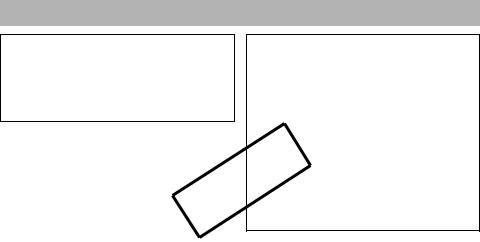
 Shooting Precautions
Shooting Precautions
As a characteristic of the diffractive optics with this lens, colored flare may occasionally appear around the light source depending on shooting conditions.
OOFor scenes where a light source is inside the screen, colored flare may occasionally appear as a halo of light
around the light source or appear fanning out from the light source.
OO For scenes where a light source is outside the screen, colored flare may occasionally appear partially inside
COPYthe screen. You can reduce or prevent these issues with the following steps according to the scene you are shooting.
• Attach a lens hood.
• Use your hand or paneling, an umbrella, etc. to block the light source and placed so that they do not appear in the screen.
ENG-3
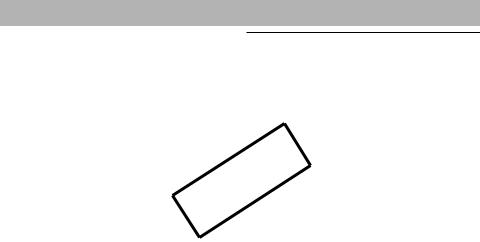
 Safety Precautions
Safety Precautions
This device complies with Part 15 of the FCC Rules. |
CAN ICES-3(B)/NMB-3(B) |
Operation is subject to the following two conditions: (1) This |
|
|
|
device may not cause harmful interference, and (2) this |
|
device must accept any interference received, including |
|
interference that may cause undesired operation. |
|
Do not make any changes or modifications to the equipment |
|
unless otherwise specified in the instructions. If such changes |
|
or modifications should be made, you could be required to |
|
stop operation of the equipment. |
|
This equipment has been tested and found to comply with |
|
the limits for a class B digital device, pursuant to part 15 |
|
of the FCC Rules. These limits are designed to provide |
|
COPY |
|
reasonable protection against harmful interference in a residential installation. This equipment generates, uses and can radiate radio frequency energy and, if not installed and used in accordance with the instructions, may cause harmful interference to radio communications.
However, there is no guarantee that interference will not occur in a particular installation. If this equipment does cause harmful interference to radio or television reception, which can be determined by turning the equipment off and on, the user is encouraged to try to correct the interference by one or more of the following measures:
•Reorient or relocate the receiving antenna.
•Increase the separation between the equipment and receiver.
•Connect the equipment into an outlet on a circuit different from that to which the receiver is connected.
•Consult the dealer or an experienced radio/TV technician for help.
ENG-4
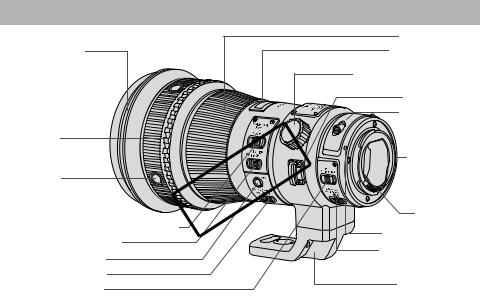
Nomenclature
Hood mount (→ 15)
Playback ring (→ 10)
AF stop button (→ 8)
Image stabilizer mode selector switch (→ 12)
Image stabilizer switch (→ 12)
Focus preset button (→ 9)
Focus preset switch (→ 9)
Focus mode switch (→ 7)
Focusing ring (→ 7)
Distance scale (→ 15)
Orientation locking knob (→ 18)
Security slot (covered) (→ 18)
Strap mount (→ 6)
Drop-in filter (→ 19)
COPY |
Rubber ring (→ 6) |
|
|
|
Contacts (→ 6) |
|
Lens mount index (→ 6) |
|
Focusing distance range |
|
selector switch (→ 7) |
|
Tripod mount (→ 18) |
OOFor detailed information, reference page numbers are provided in parentheses (→ **).
ENG-5
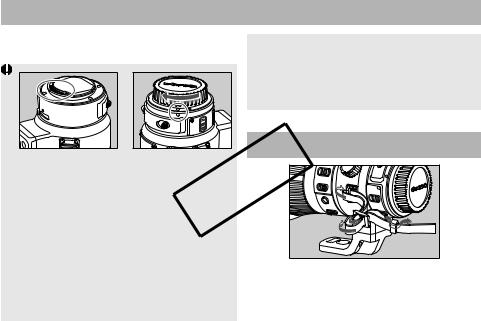
1. Mounting and Detaching the Lens
See your camera’s instructions for details on mounting and detaching the lens.
 The lens mount has a rubber ring for enhanced dustand water-resistance. The rubber ring may cause slight abrasions around the camera’s lens mount, but this will not cause any problems. If the rubber ring becomes worn, it is replaceable by a Canon Service Center at cost.
The lens mount has a rubber ring for enhanced dustand water-resistance. The rubber ring may cause slight abrasions around the camera’s lens mount, but this will not cause any problems. If the rubber ring becomes worn, it is replaceable by a Canon Service Center at cost.
OOAfter detaching the lens, place the lens with |
Attaching the strap |
|
|
||
the rear end up to prevent the lens surface and |
|
|
contacts from getting scratched. |
|
|
OOIf the contacts get soiled, scratched, or have |
|
|
fingerprints on them, corrosion or faulty |
|
|
connections can result. The camera and lens |
|
|
may not operate properly. |
COPY |
|
|
||
OOIf the contacts get soiled or have fingerprints on |
|
|
them, clean them with a soft cloth. |
|
|
OOIf you remove the lens, cover it with the dust cap. |
Thread the end of the strap through the strap |
|
To attach it properly, align the lens mount index |
||
and the index of the dust cap as shown in |
mount on the lens and then back through the |
|
the diagram, and turn clockwise. To remove it, |
clasp on the strap. Pull the strap tight and check |
|
reverse the order. |
|
that there is no slack in the clasp. |
ENG-6
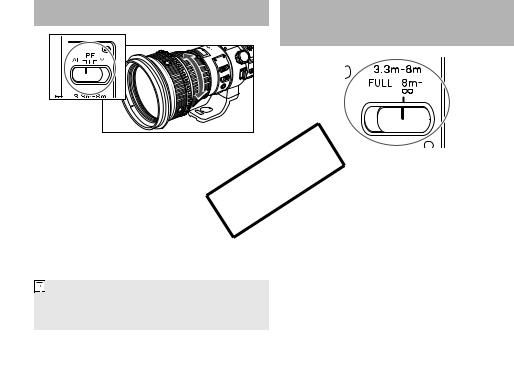
2. Setting the Focus Mode 3. Switching the Focusing Distance Range
|
|
|
|
|
|
|
|
|
|
|
|
|
|
|
|
|
|
|
|
|
|
|
|
|
|
|
|
|
|
|
|
|
|
|
|
|
|
|
|
|
|
|
|
|
|
|
|
|
|
|
|
|
|
|
|
|
|
|
|
|
|
|
|
|
|
|
|
|
|
|
|
|
|
|
|
|
|
|
|
|
|
|
|
|
|
|
|
|
|
|
|
|
|
|
|
|
|
|
|
|
|
|
|
|
|
|
|
|
|
|
|
|
|
|
|
|
|
|
|
|
|
|
|
|
|
|
|
|
|
|
|
|
|
|
|
|
|
|
|
|
|
|
|
|
|
|
|
|
|
|
|
|
|
|
|
|
|
|
|
|
|
|
|
|
|
|
|
OOTo shoot in autofocus (AF) mode, set the focus |
|
|
|
|
|
|
|
|
|
|
|
|||||||||
mode switch to AF. |
|
|
|
|
|
|
|
|
|
|
|
|
|
|||||||
COPY |
||||||||||||||||||||
|
|
|
|
|
|
|
||||||||||||||
OOTo shoot in manual focus (MF) mode, set the |
You can set the focusing distance range with a |
|||||||||||||||||||
switch. By setting a suitable focusing distance |
||||||||||||||||||||
focus mode switch to MF, and focus by turning |
||||||||||||||||||||
range, the actual autofocusing time will be |
||||||||||||||||||||
the focusing ring. The focusing ring always |
||||||||||||||||||||
shorter. |
||||||||||||||||||||
works, regardless of the focus mode. |
||||||||||||||||||||
|
|
|
|
|
|
|
|
|
|
|
||||||||||
OOTo shoot in power focus (PF) mode, set the |
|
|
|
|
|
|
|
|
|
|
|
|||||||||
|
Ranges |
|
|
|
|
|
|
|||||||||||||
focus mode switch to PF when the focus |
|
|
|
|
|
|
|
|
|
|
|
|||||||||
|
FULL |
|
|
|
|
|
|
|||||||||||||
preset switch (p. 9) is at OFF. For detailed |
|
|
|
|
|
|
|
|||||||||||||
(3.3 m/10.83 ft. - ∞) |
|
|
|
|
|
|
||||||||||||||
information, see “6. Power Focus (PF) Mode” |
3.3 m/10.83 ft. – 8 m/26.25 ft. |
|
|
|
|
|
|
|||||||||||||
(p. 11). |
|
|
8 m/26.25 ft. - ∞ |
|
|
|
|
|
|
|||||||||||

 After autofocusing in ONE SHOT AF mode, focus manually by pressing the shutter button halfway and turning the focusing ring. (Full-time manual focus)
After autofocusing in ONE SHOT AF mode, focus manually by pressing the shutter button halfway and turning the focusing ring. (Full-time manual focus)
ENG-7
